Introduction
Jerk is a popular traditional snack food around the world. It is highly nutritious (low fat and high protein) with a long shelf-life due to its low water activity and lack of refrigeration requirements during market distribution (Allen et al., 2007). In addition, jerky is a flexible food item that may be produced from a range of meats, including beef, pork, chicken, turkey, and even fish (Han et al., 2007). Due to its adaptability, jerky can be enjoyed by a variety of consumers with various dietary preferences and restrictions. However, the texture is the main factor affecting the sensory evaluation of jerky products. Dehydration tends to decrease water activity during drying, which results in a tough texture. Excessively dry jerky is not preferred by consumers (Jang et al., 2015). Therefore, it should be addressed by food industries to fulfil consumers’ expectations. Moreover, the population of older people is growing in the human community. It is difficult for them to eat jerky due to its tough texture (Farouk et al., 2018). Therefore, food industries must provide meat products suitable for seniors by regulating standards that ensure enough protein intake for older people’s health. Recently, many researchers have conducted studies focusing on adjusting the texture of jerky by changing marination formulas (Choi et al., 2008), adding salt (Lee et al., 2004), changing drying temperature (Han et al., 2007), changing drying time (Kim et al., 2006), and changing packing techniques (Choi et al., 2007). The use of humectants is a typical method for enhancing jerky’s texture (Kim et al., 2021).
Humectants are hygroscopic organic substances that can absorb and hold onto water, enhancing the softness and texture of food (Kim et al., 2021). Moreover, humectants are frequently molecules having numerous hydrophilic groups, the majority of which are hydroxyl groups. However, amine and carboxyl occasionally appear as esterification groups with a propensity to form hydrogen bonds with water molecules (Thushara et al., 2022). In particular, humectants have the major benefit of not affecting pH in aqueous systems due to their non-ionic nature (Msagati, 2012). In addition, humectants have antioxidant activity and the capacity to chelate metals, which can help prevent the oxidation of meat products (Jang et al., 2021). Moreover, humectants can affect food items’ preservation since they can keep products moisturized. When chemical reactions and microbiological activity due to moisture cannot be controlled, the shelf life of a product is shortened (Severini et al., 2008). In addition, the United States Food and Drug Administration (US FDA) has designated humectants as “generally recognised as safe (GRAS)” when they are added to foods (Wexler et al., 2005). Therefore, many researchers have tried to improve the quality properties of jerky by adding humectants such as konjac, egg albumin, isolated soy protein, sucrose, glycerol, xylitol, sorbitol, duck skin, and carrageenan (Han et al., 2011; Jang et al., 2021; Kim et al., 2020; Sorapukdee et al., 2016).
There have been more than 3,380 articles published in Google Scholar since 2000 that discuss the use of humectants in meat products. A lot of research-related information has been published on how humectants affect quality characteristics in jerky at both national and international levels. Meanwhile, several studies stated that the effects of humectants were applied to jerky. Chen et al. (2000) claimed that the tenderness of Chinese-style pork jerky increased by adding more glycerol and sorbitol. Han et al. (2011) reported that adding 0.1% and 0.2% konjac observed similar quality characteristics during jerky production. Therefore, there is controversy and there isn’t enough information in the findings to get exhaustive results. So, in order to gather data on these issues in the field of meat processing, a meta-analysis study needs to be conducted.
A meta-analysis is a statistical analysis that incorporates the findings of various scientific investigations. Meta-analysis can be conducted when a single scientific question is the subject of several studies, with each of those studies reporting quantitative results that are anticipated to contain some degree of error (Hak et al., 2016). Meta-analysis can provide a pooled estimate that is closest to the unknown common truth from statistics based on this error (Ortiz et al., 2021). Therefore, meta-analysis is currently being utilised more frequently in the sciences as a tool for testing hypotheses. This study aimed to assemble exhaustive information through meta-analysis. In addition, the meta-analysis aimed to evaluate how humectants affected jerky’s moisture content, water activity, tenderness, color attributes, microbiological analysis, protein denaturation, and oxidation. Results of this study will provide information on humectants as a way to enhance the quality attributes of jerky.
Materials and Methods
A thorough search of the full-text available research that was accessible from 2010 to 2022 was conducted to identify experiments that were specifically designed to examine the impact of humectants on the quality attributes of jerky. The following databases were searched: Web of Science (https://www.webofscience.com/wos/woscc/basic-search), Google Scholar (https://scholar.google.com/), PubMed (https://pubmed.ncbi.nlm.nih.gov/), and Science Direct (https://www.sciencedirect.com/) by using the keywords. Jerky and humectants were used as keywords, and the order of priority for the results was used. For the purpose of choosing articles to be included in the database for meta-analysis, the following factors were taken into consideration: (a) moisture; (b) water activity; (c) pH; (d) protein; (e) fat; (f) ash; (g) shear force; (h) total plate count (TPC); (i) thiobarbituric acid reactive substances (TBARS); (j) color (CIE L*, CIE a*, and CIE b*); (k) Myofibrillar fragmentation index (MFI); and (l) overall acceptability.
Studies that did not match the inclusion criteria were excluded following the Preferred Reporting Items for Systematic Reviews and Meta-Analyses (PRISMA) guidelines (Moher et al., 2009). Fig. 1 displays a flow diagram of obtained data. The inclusion and exclusion criteria for the studies in the meta-analysis were clearly stated and justified. Among these, only 14 papers satisfied the inclusion criteria (Table 1). They were utilised to synthesise the quantitative results via meta-analysis. These papers were used to obtain the mean, SD, and replication number for each treatment. When researchers used the various levels of additives in each humectant in these articles, the appropriate levels of the additive for meta-analysis were gathered based on the highest scores of overall acceptance of sensory analysis that the sensory panelists assessed.
| No. | Authors | Jerky | NC | Humectants | Level (%) of each humectant |
|---|---|---|---|---|---|
| 1 | Kim et al. (2010a) | Pork | 5 | Glycerol, sorbitol, kiwi, pineapple | 5, 5, 2, 2 |
| 2 | An et al. (2010) | Pork | 2 | Kimchi powder | 2 |
| 3 | Kim et al. (2010b) | Pork | 2 | Rice bran fibre | 2 |
| 4 | Han et al. (2011) | Chicken | 4 | Konjac, isolated soy protein, egg albumin | 0.2, 0.2, 0.2 |
| 5 | Kim et al. (2012a) | Chicken | 4 | Wheat fibre, chicken feet gelatin | 2, 1, 4 |
| 6 | Kim et al. (2015) | Chicken | 2 | Chicken feet gelatin | 1 |
| 7 | Jang et al. (2015) | Beef | 4 | Sorbitol, glycerol, xylitol | 2.5, 5, 5 |
| 8 | Choi et al. (2016) | Chicken | 3 | Chicken skin, acid-treated chicken skin | 5, 5 |
| 9 | Park and Kim (2016) | Pork | 2 | Black rice powder | 3 |
| 10 | Lee and Kim (2016) | Chicken | 2 | Red pepper seed powder | 3 |
| 11 | Sorapukdee et al. (2016) | Spent hen | 3 | Glycerol, sorbitol | 15, 15 |
| 12 | Chen and Lin (2017) | Pork | 4 | Sucrose, lactose, maltose | 24, 24, 18 |
| 13 | Kim et al. (2020) | Pork | 4 | Carrageenan, duck skin gelatin | 1, 1.3 |
| 14 | Aung et al. (2023a) | Goat | 3 | Pineapple, pineapple and tomato | 0.5, 0.5 |
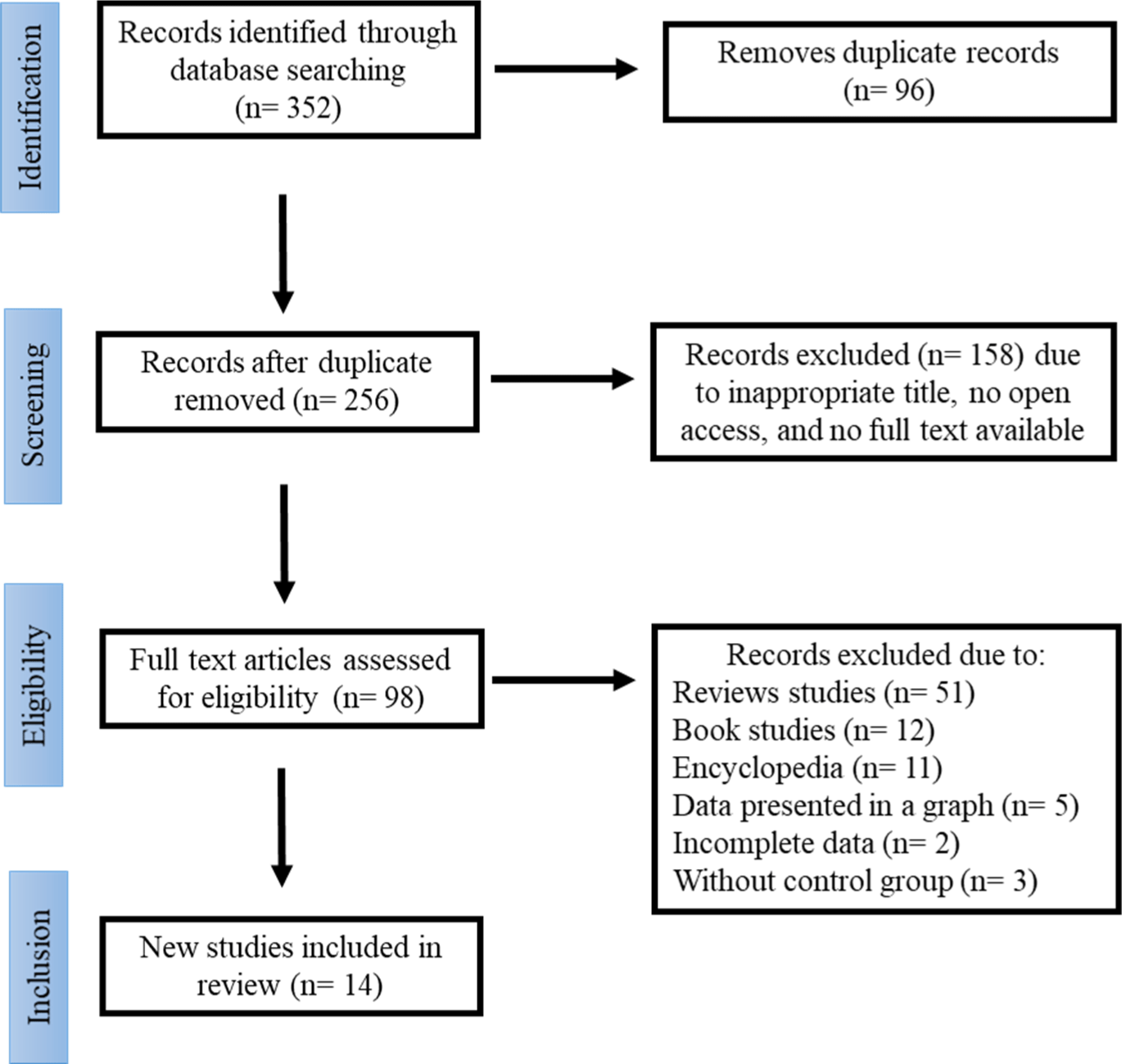
Meta-analysis and meta-regression data were examined using the R statistical software (version 4.2.3). To analyse response variables, the standardised mean difference (SMD), also referred to as effect size (ES), which was derived using the SD of the groups with and without humectants, was utilised. The SMD with a 95% confidence interval was computed using the mean of the experimental and control groups as a reference. In instances where SD was not recorded, it was computed by dividing the reported SEM by the square root of the sample size. SMDs were analyzed using the procedures previously outlined for random-effects models (DerSimonian and Laird, 1986). The SMD was calculated with the following formula:
where was the mean for the treatment group, was the mean for the control group, and Sp was the pooled SD (Lean et al., 2009).
In addition, the meta-analysis employed a random-effect model operating under the fundamental presumption that effects were distributed randomly, giving rise to heterogeneity in the results of the research (Borenstein et al., 2010). When the data set contains heterogeneity, the SMD offers a more reliable estimate of the ES (Lean et al., 2009).
Statistical heterogeneity demonstrates the variations in different jerky, study designs, and quality issues, which can suggest whether the true effects in each trial are the same (Sutton and Higgins, 2008). The chi-square test (Q) and I2 were used to assess heterogeneity (Borenstein et al., 2010; Borenstein et al., 2021; Higgins and Thompson, 2002). Q test was utilized with an α (0.1) level due to the relatively low capacity to detect heterogeneity among a few treatment comparisons (Huedo-Medina et al., 2006; Lean et al., 2009). I2 indicate the percentage of variation among studies in meta-analysis. Its value ranges from 0% to 100% with values close to 25%, 50%, and 75% suggesting low, moderate, and high levels of study heterogeneity respectively (Borenstein et al., 2009; Borenstein et al., 2010; Higgins et al., 2003). I2 values over 50% also imply a considerable amount of heterogeneity (Lean et al., 2014).
Investigating sources for heterogeneity of ES is done using meta-regression (Gonzalez-Ronquillo et al., 2022). Meta-regression is used to evaluate and regulate possible sources of heterogeneity, such as variations in humectants. Therefore, it was applied to determine causes of parameter heterogeneity whenever Q had α level ≤0.10 or I2 had increased to more than 50%. Through the use of meta-regression, it is possible to determine whether there is a linear relationship between certain variables and the outcome of a comparative therapy as well as its strength (Baker et al., 2009). According to DerSimonian and Laird’s methodology, meta-regression was carried out (Borenstein et al., 2010). Factors with an additive level were employed in this study as variables for data with heterogeneity. In addition, when categorical factors in meta-regression had significance at an α level of ≤0.05, SMD was evaluated using subgroup analysis by dividing covariates as follows: additive level <5% and additive level ≥5% (Orzuna-Orzuna et al., 2021a; Torres et al., 2020). Subgroup analysis based on humectant levels was considered to investigate the potential variations.
There are three ways to evaluate the presence of publication bias: (1) funnel plot (Higgins and Thompson, 2002); (2) Begg’s adjusted rank correlation (Begg and Mazumdar, 1994); and (3) Egger’s regression asymmetry test (Egger et al., 1997). Bias was defined as the presence of either asymmetry in the funnel plot or a significant result from at least one of the statistical tests (Begg’s test or Egger’s test) with a significance level of p<0.05 (Orzuna-Orzuna et al., 2021b). The trim-and-fill approach was used to determine the number of missing observations when substantial (p<0.10) bias was identified. When the variable being tested is not included in at least 10 papers and considerable heterogeneity (Q) is found with p≤0.10, tests to measure publication bias should be avoided since they could provide false-positive results (Ioannidis and Trikalinos, 2007).
Results and Discussion
Meta-analysis findings of humectant-infused jerky’s quality attributes are shown in Table 2. When humectants were added, jerky’s moisture, CIE b*, MFI, and overall acceptance increased significantly (p<0.05), while protein amount, shear force, and metmyoglobin decreased significantly (p<0.05). However, the effects of adding humectants on water activity, pH, fat, ash, TPC, TBARS, CIE L*, and CIE a* were not statistically significant (p>0.05).
The manufacturing and quality of jerky are greatly influenced by moisture, which also affects drying, texture, flavor, and shelf life. Therefore, managing jerky’s moisture content is crucial to producing the desired texture, flavor, and shelf life. The effects of adding humectants on the moisture content of jerky were compared among 29 studies with various jerky types (beef, chicken, goat, and pork). According to the meta-analysis, the addition of humectants resulted in a significant increase in the moisture content of jerky (SMD=1.74, p<0.05). A heterogeneity test is needed before making a definite conclusion from these results. The forest plot showed significant (p<0.05) variability among studies. This was also confirmed by I2 at 61.9% (Fig. 2). According to Jang et al. (2015), humectants’ hygroscopic properties such as sugar alcohol and their larger molecular weight can stop fluctuations in the moisture content of meals. In addition, humectants are chemicals that can absorb and hold water, contributing to greater moisture content in final meat products (Kim et al., 2021). The process of hygroscopy, which takes in water from the environment and holds onto it, is likely to explain how humectants work to draw and hold moisture in jerky. This prevents the products from drying out too much and maintains their moisture contents, which can help to extend the shelf life and improve the texture and flavor of jerky.
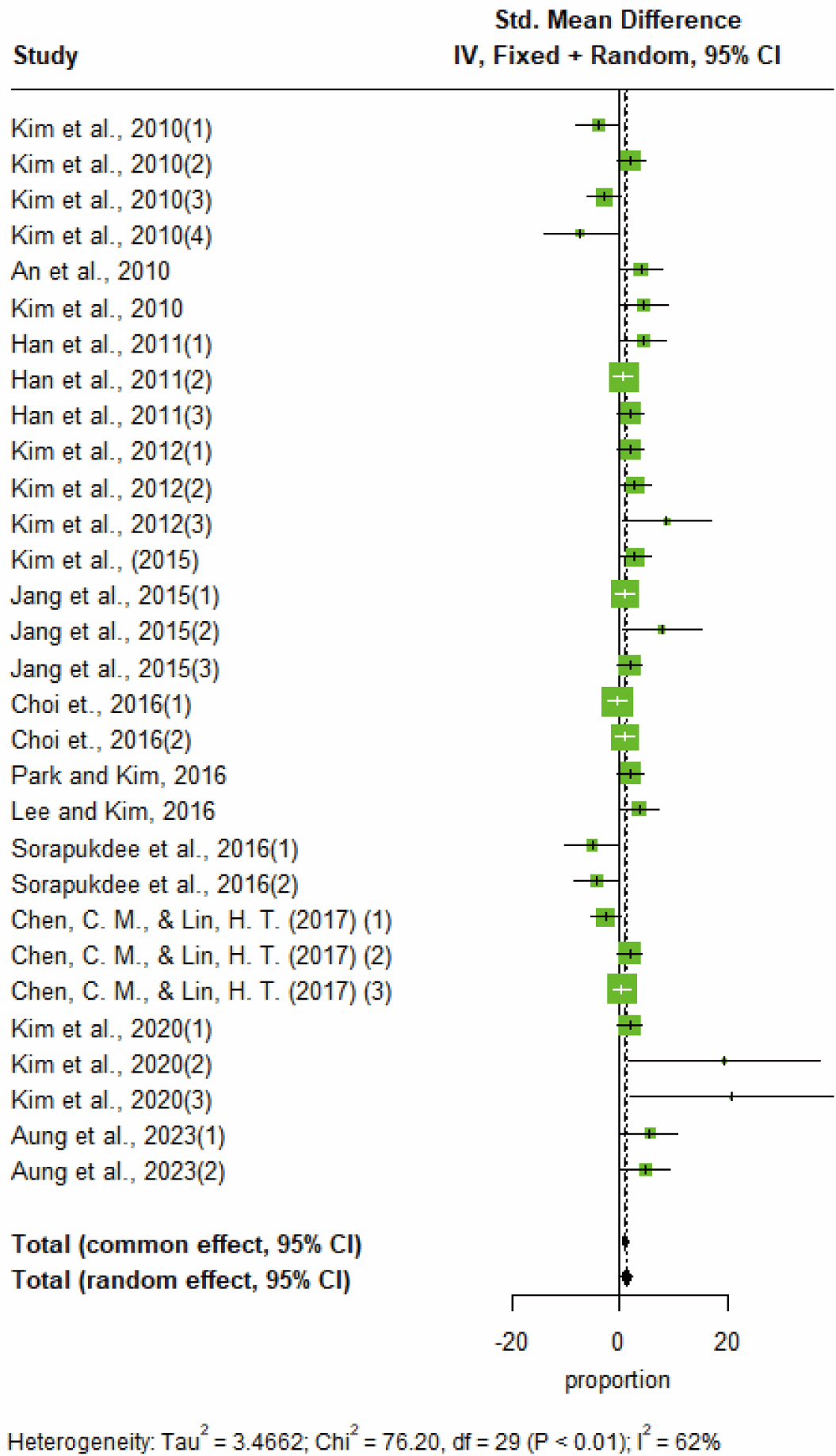
The availability of water present in food products, known as water activity (aw), is a key factor regulating the shelf life and quality of food products (such as jerky), including microbial growth, texture, flavor, and weight loss (Mathlouthi, 2001). Meta-analysis was used to assess 20 research studies to find out how humectants affected the water activity of jerky. The heterogeneity analysis revealed a low variability among studies (I2=22.9%, p>0.05). The water activity was decreased during the production of the jerky using humectants, although such a decrease was not statistically significant (SMD=–0.26, p>0.05). Humectants with a low molecular weight tend to raise the osmotic pressure, which can cause water activity to decrease (Ko, 2006). Humectants presumably can reduce the water activity (aw) of jerky due to their hygroscopic properties. When humectants are added to jerky, they take on the role of a sponge, drawing moisture into the food and holding it there.
The texture of jerky is one of the key distinguishing characteristics and crucial sensory quality of jerky for consumers. The meta-analysis for the effects of humectants on the texture of jerky evaluated the shear force values in 17 papers. Results revealed that humectants considerably reduced the jerky’s shear force value (SMD=–0.84, p<0.05). The heterogeneity analysis indicated that there was no variability among studies. This was confirmed by I2 (0%; Fig. 3). The dietary fibre included in certain humectants can physically trap protein and water, increasing their ability to hold water and changing the texture of the final product (Kim et al., 2021). Water activity, moisture content, and cooking yield can all influence shear force values (Choe et al., 2007; Choi et al., 2010). A higher moisture value might be related to a high shear force value. The way humectants change the texture of jerky is by maintaining moisture in the meat, which keeps the meat tender and pliable and prevents it from becoming too dry and brittle.
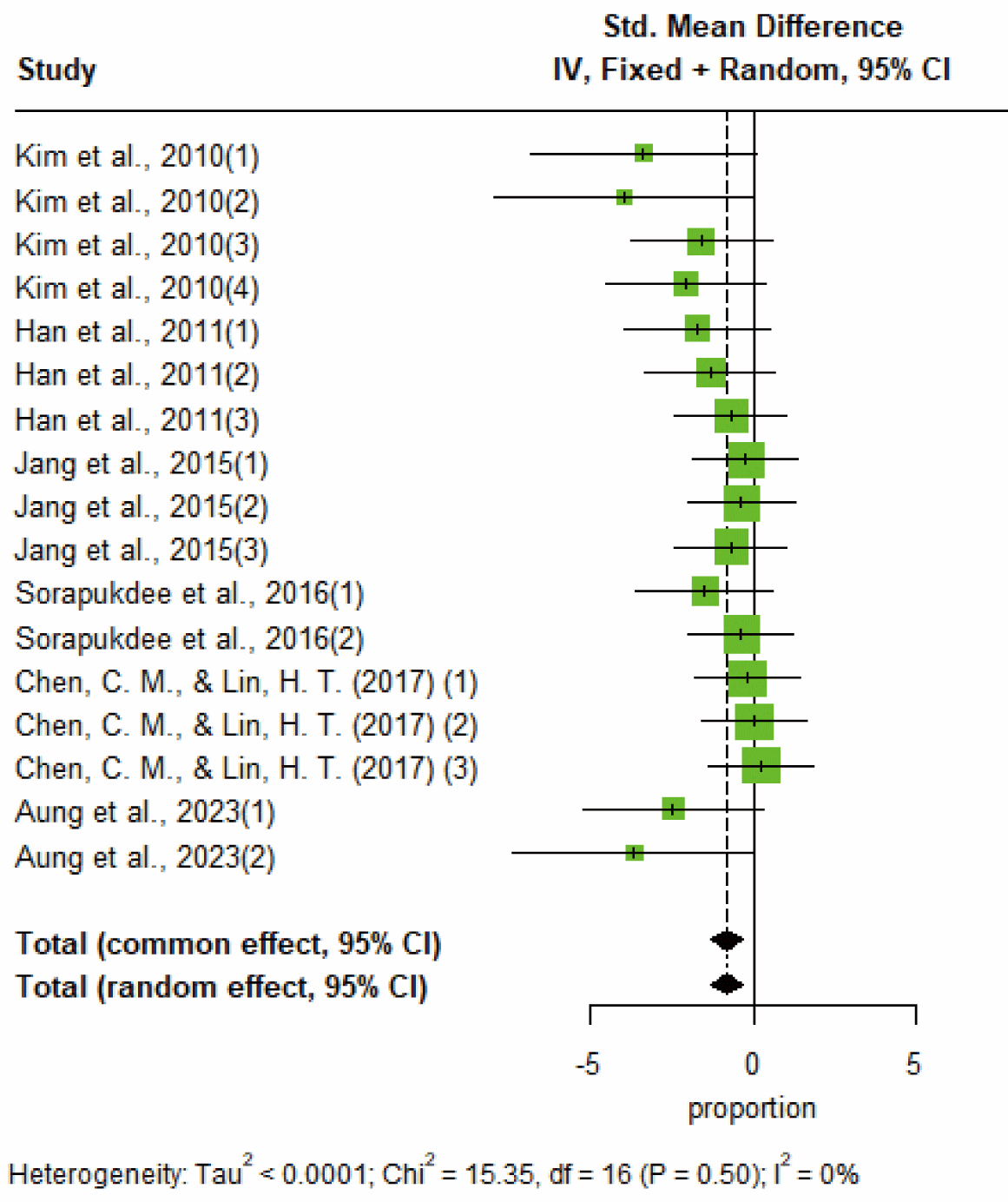
Proteolysis is one of the major factors determining meat tenderness in meat products (Kim et al., 2013). The MFI measures the degree of protein denaturation in meat processing. Variations in this index might indicate changes in the structural integrity of muscle fibres (Ali et al., 2023b). The results of the meta-analysis showed that the MFI value was significantly increased by adding humectants (SMD=3.22, p<0.05). There was diversity across all of the research according to the examination of heterogeneity on the MFI value (I2=70, p<0.05) but it was lower than in 10 studies to conclude. Higher MFI values indicate a greater degree of fragmentation of the myofibrils and, therefore, a more tender meat product. MFI is highly related to shear force (Culler et al., 1978; Olson and Parrish, 1977). The results of the current meta-analysis confirmed this finding. It is known that humectants such as glycerol can have a hydrating effect on muscle tissue and potentially affect the mechanical properties of the muscle fibres, which can raise the MFI.
CIE L*, CIE a*, and CIE b* of color characteristics were studied in the meta-analysis to determine how humectants impacted them. Results revealed that humectants increased the CIE L* and CIE a* of jerky, although such increases were not statistically significant (SMD=0.2 and 0.49, respectively, p>0.05). Probably, the ability to retain the moisture of humectants can affect the appearance of the jerky. When humectants are added to jerky, they can help preserve the moisture level. The added moisture might give the product a brighter appearance. Humectants may draw in water, preventing the jerky from drying out and enhancing light scattering, resulting in a light final product (Sorapukdee et al., 2016). However, there is a significant increase in CIE b* of jerky by adding humectants (SMD=0.172, p<0.05). The CIE b* of meat or meat products is correlated with pH (Teixeira et al., 2011). The current meta-analysis found that humectants had a subtle effect on the pH of jerky. The heterogeneity analysis indicated high variabilities in CIE L*, CIE a*, and CIE b* of all studies (I2=55.5%, 50%, and 65.2%, respectively, p<0.05). The forest plot showed the results of multiple studies, the overall ES, and the variability of the findings for CIE b* (Fig. 4).
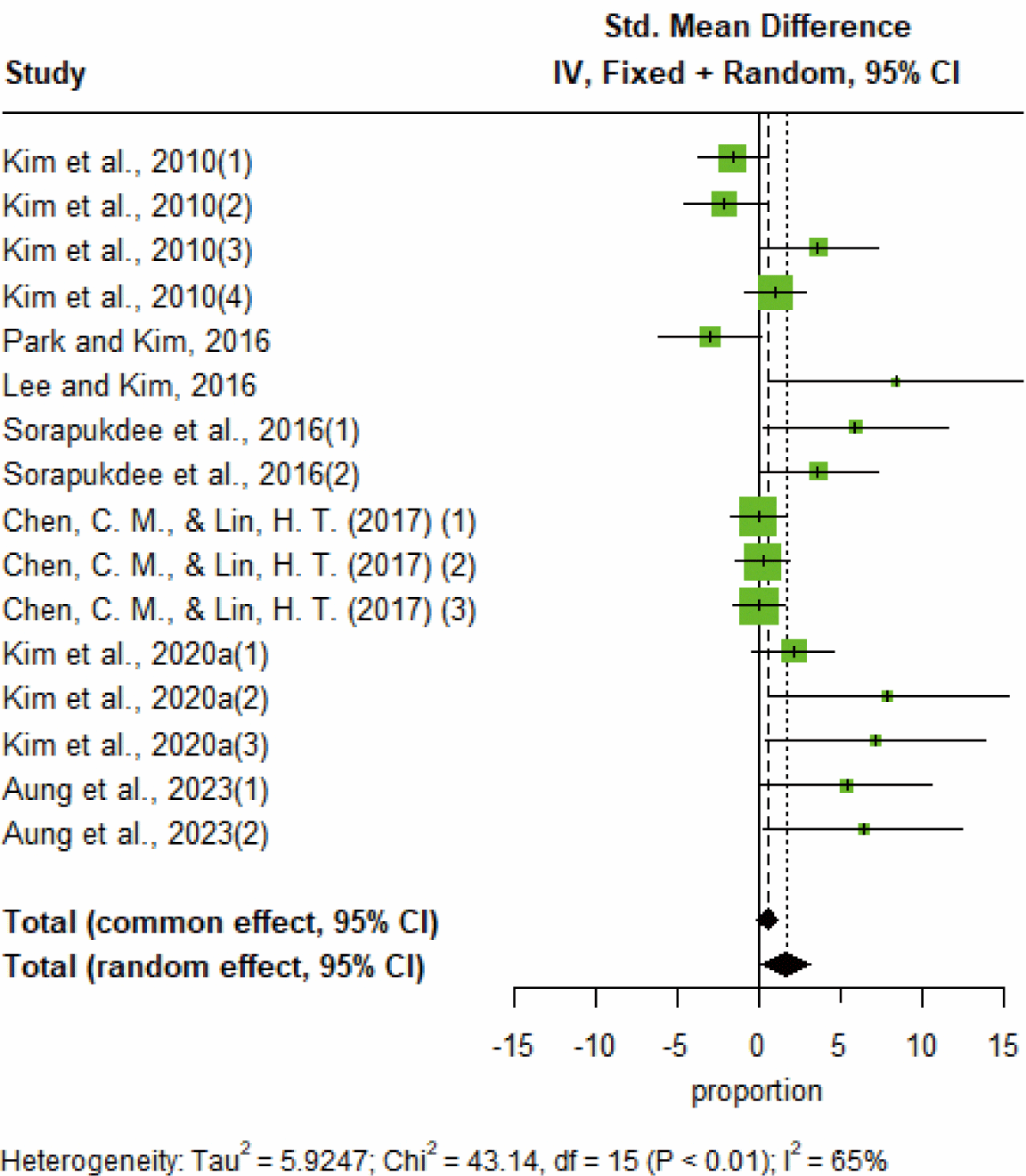
The pH of jerky is an important factor that affects its texture, flavor, and safety. Jerky with a high pH is more susceptible to spoilage which affects its texture and flavor (Singh and Anderson, 2004). The meta-analysis found that jerky added with humectants did not show a significant increase in pH (SMD=0.12, p>0.05). The heterogeneity analysis revealed moderate variabilities across studies with the confirmation of I2 (43.4%, p<0.05). This implies that adding humectants to jerky will not affect the reduction of harmful bacterial growth or the avoidance of spoiling. Some researchers have mentioned that the reduction of pH in jerky could be due to a low pH value of adding humectants (Kim et al., 2012b) or containing organic acids in humectants (Kim et al., 2010b).
The TPC measures the number of live bacteria in a food sample. TPC is frequently used to assess the quality and safety of food. It serves as an indicator of the total bacterial load in food (Ali et al., 2023a). According to the results of the current meta-analysis, the TPC of the jerky was marginally increased by humectants (SMD=0.45, p>0.05). Such an increase was not statistically significant. The heterogeneity analysis showed high variability in all studies (I2=59.8%, p<0.05), however, the number of studies was lower than in 10 to make a definite conclusion. In general, products with higher moisture content are more susceptible to bacterial growth, which can increase the TPC of the product (Rolfe and Daryaei, 2020). In addition, the higher the water activity of a food product, the more favourable conditions for bacterial growth (Troller, 2012). The current research indicated that humectants could increase moisture content while only marginally reducing the product’s water activity, which resulted in a minimal increase in TPC.
TBARS assay is a test used to measure the level of lipid oxidation in food products (Aung et al., 2023b). The test examines the number of aldehydes which is an indicator of deterioration and a factor affecting jerky’s flavor and quality. Aldehydes are created when unsaturated fatty acids are oxidized. A low TBARS value suggests that the jerky has undergone little oxidation. Therefore, the jerky is more likely to have a longer shelf life and is of higher quality. According to the current data, adding humectants to jerky had no significant impact on TBARS (SMD=0.3, p>0.05) but it was lower than in 10 studies to conclude. The heterogeneity analysis for TBARS indicated a high variability across studies with verified high I2 at 61% (p<0.05). In general, humectants can aid in maintaining the jerky’s moisture content, which can slow down the oxidation of lipids and lessen the production of aldehydes because water molecules can interfere with the reaction and reduce the available oxygen. This can lead to a lower malondialdehyde value, which would imply a longer shelf life.
Metmyoglobin causes a brownish-grey color of meat and meat products. It is not attractive to consumers (An et al., 2010). The iron-containing substances in myoglobin can combine with oxygen to generate metmyoglobin when exposed to air, which gives the meat its characteristic brown or grey color (Mancini, 2013). The flavor and texture of the jerky could be harmed by this change in color, which could indicate rotting. According to the meta-analysis, humectants significantly decreased the metmyoglobin content of jerky (SMD=–0.96, p<0.05). The forest plot revealing the overall ES and variability of metmyoglobin in all studies is shown in Fig. 5. The heterogeneity analysis showed low variability (I2=23.9%, p>0.05). Thus, humectants work well to denature metmyoglobin and enhance the visual presentation and sensory qualities of jerky. In addition, the percentage of metmyoglobin has a positive correlation with the TBARS value in meat products (Bekhit et al., 2003). Metmyoglobin is produced when myoglobin is oxidized. TBARS is a test that assesses the degree of lipid oxidation. Therefore, it is probable that they could be an indicator of a decline in the quality of the product. The flavor and quality of the jerky will increase when the amount of metmyoglobin formation is decreased, signalling that the food is safe.
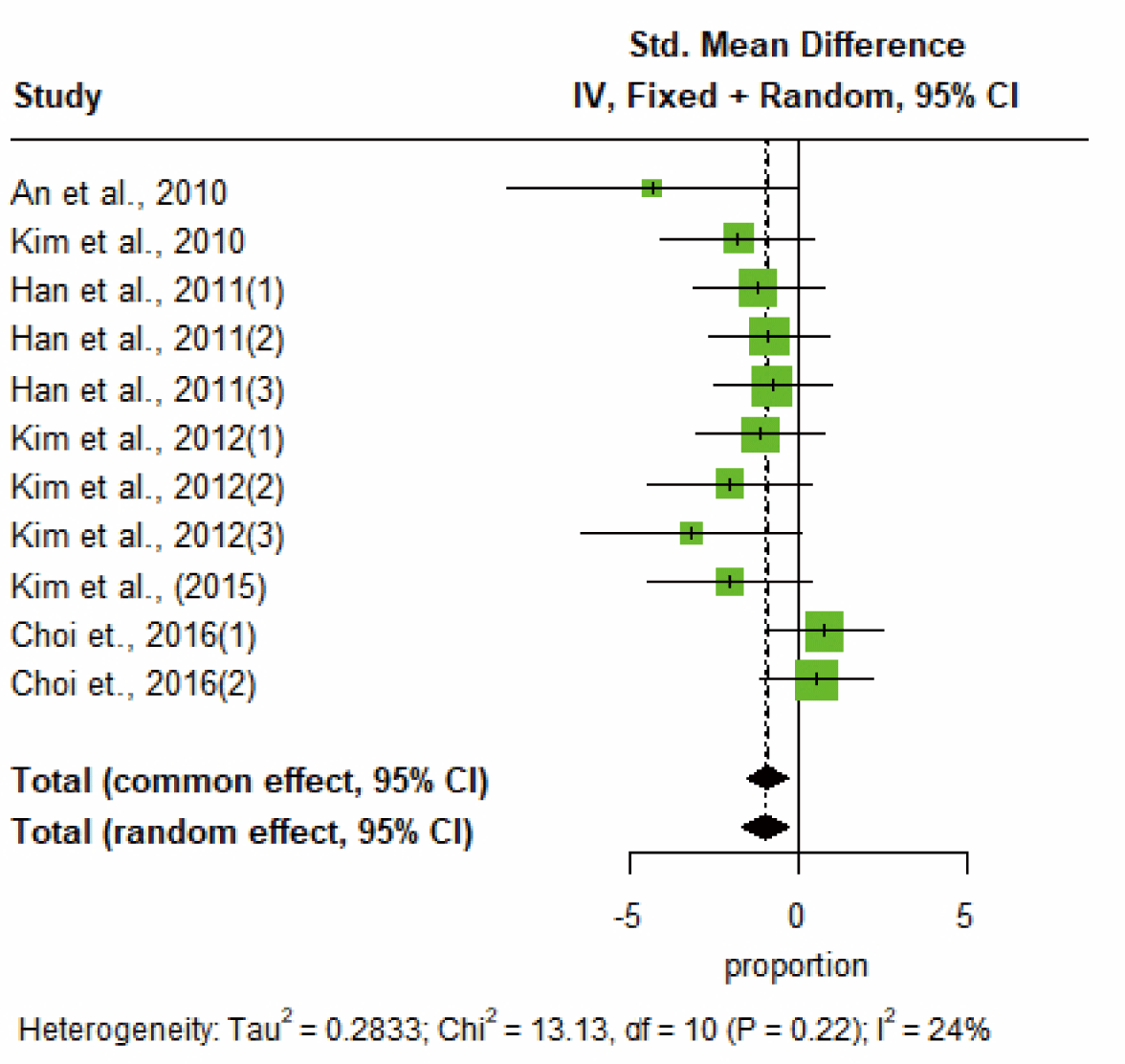
Jerky’s protein level varies depending on the kind of meat used and how it is processed, but in general, it is regarded as a decent source of protein. In this meta-analysis, protein content was significantly decreased in jerky when humectants were added (SMD=–1.61, p<0.05). Fig. 6 shows a forest plot of overall ES and variability. The heterogeneity analysis showed high variability, which was confirmed by I2 (56.1%, p<0.05). Humectants will likely help a product retain more moisture, which could then interact with protein molecules. It may result in the unfolding or denaturation of the proteins, which could lower jerky’s protein level. In addition, this is possible due to the higher moisture retention compared to the control jerky, which leads to a concentration effect on the remaining components, including protein. During the jerky-making process, proteins might also be subjected to high temperatures or dehydration, which can also result in a decrease in protein concentration. Protein is a crucial component of jerky, as it provides the product with its structure and texture (Kumar et al., 2019). The overall protein composition of the jerky might be affected by the humectant selection.
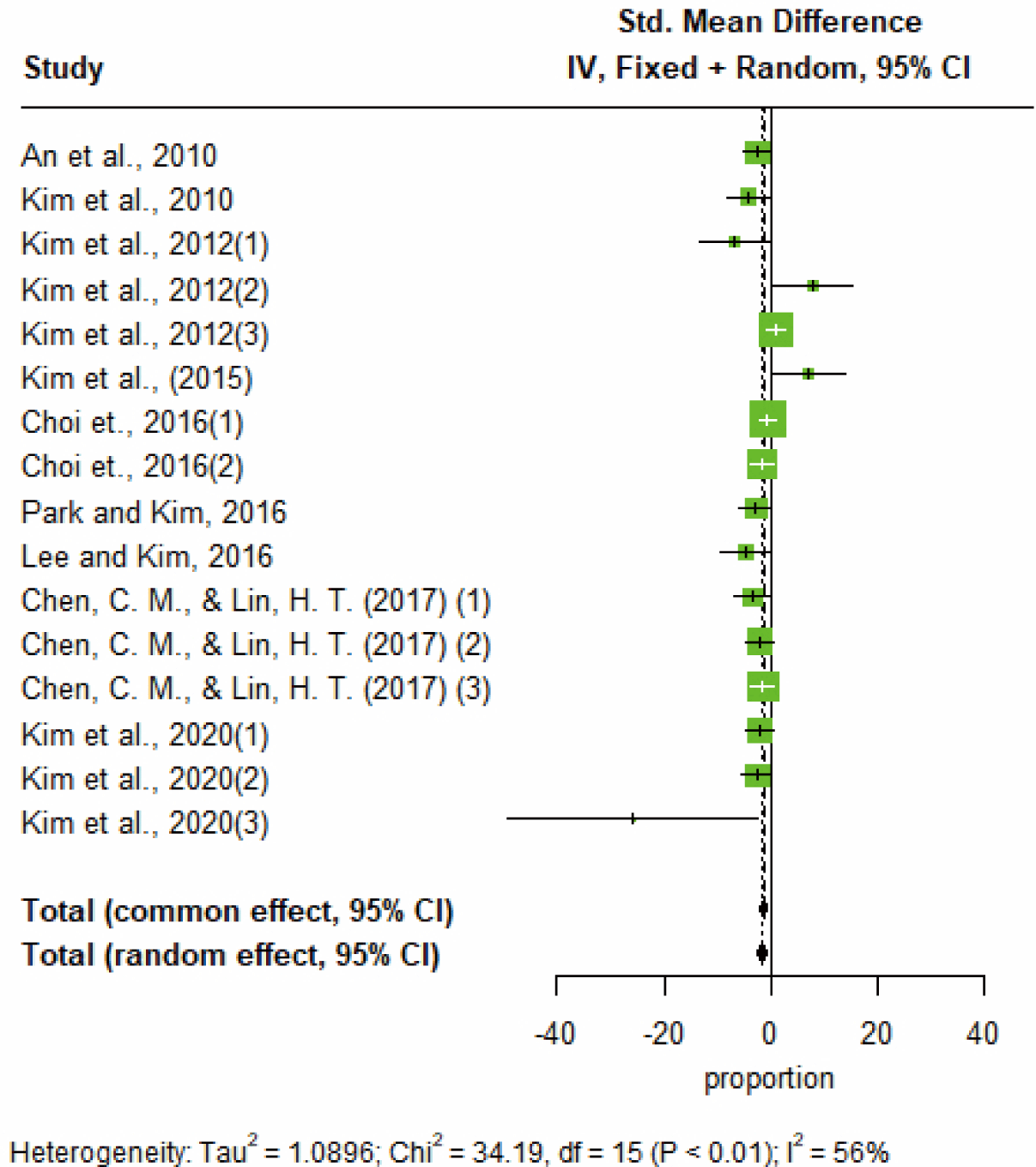
Juice, flavor, and texture all benefit from the presence of fat in meat products (Moloney, 2006). However, jerky spoils more quickly as a result of the fat. If additives have dietary fibre, they can promote fat retention in meat products (Thebaudin et al., 1997). However, humectants have no significant impact on the fat content of jerky (SMD=–0.09, p>0.05) in the current analysis. Heterogeneity analysis showed moderate variability between individual studies with an I2 value of 44% (p<0.05). Generally, humectants can retain moisture which can cause the jerky to become moist resulting increase in the texture without directly affecting the fat content of the meat. Jerky’s fat level is mostly influenced by the fat content of the meat used and any additional fat added during the processing. Increasing fat content can cause more susceptibility to rancidity. Therefore, it is essential to use the proper kind and amount of humectant while making jerky to ensure that the final product has the desired fat level and shelf life.
Ash content in meat products refers to the amount of inorganic mineral matter that remains after the products are burned or incinerated (Perez and Andujar, 1981). Therefore, the ash content can provide information about the presence of inorganic minerals and contaminants (heavy metals, salts, or other inorganic substances) as well as the completeness of the drying process. According to the current study, the jerky’s ash concentration was reduced when humectants were added, although the decrease was not statistically significant (SMD=–1.59, p>0.05). The heterogeneity analysis showed a high variability in all studies (I2=67.1%, p<0.05). However, it has been shown that adding dietary fibre to meat products can cause the ash content to rise dramatically (Choi et al., 2010; Lee et al., 2008; Serrano et al., 2007). In the case of jerky, the addition of a humectant can increase the overall moisture content of the product. As a result, there might be less ash present since the humectant will bind to the food’s minerals, allowing them to dissolve into the moisture and lowering the quantity of ash that remains after burning.
In recent years, there has been an increased demand for healthier food options. Many consumers are looking for jerky products that are high in protein, low in sugar and fat, and made from high-quality, natural ingredients. Overall acceptability of jerky varies among consumers as it is subjective. Flavor, texture, and color are the most crucial sensory characteristics of jerky products (Albright et al., 2003). According to the present meta-analysis, adding humectants could significantly increase the overall acceptability (SMD=1.73, p<0.05). Fig. 7 shows the overall ES and variability. The heterogeneity analysis indicated a high variability which was verified by I2 at 88.1% (p<0.05). The sensory qualities, purchasing behavior, and market share of meat products like jerky are most strongly influenced by texture (Choi et al., 2008; Guerrero et al., 1999). According to this study, humectants can provide jerky tenderness which might relate to the high overall acceptability. It is possible that humectants can positively impact the texture and chewiness of jerky by controlling the moisture that is pleasant to eat. In addition, humectants can impact the flavor of jerky by interfering with the natural taste and aroma of the meat. Therefore, humectants could make jerky a desirable snack for consumers.
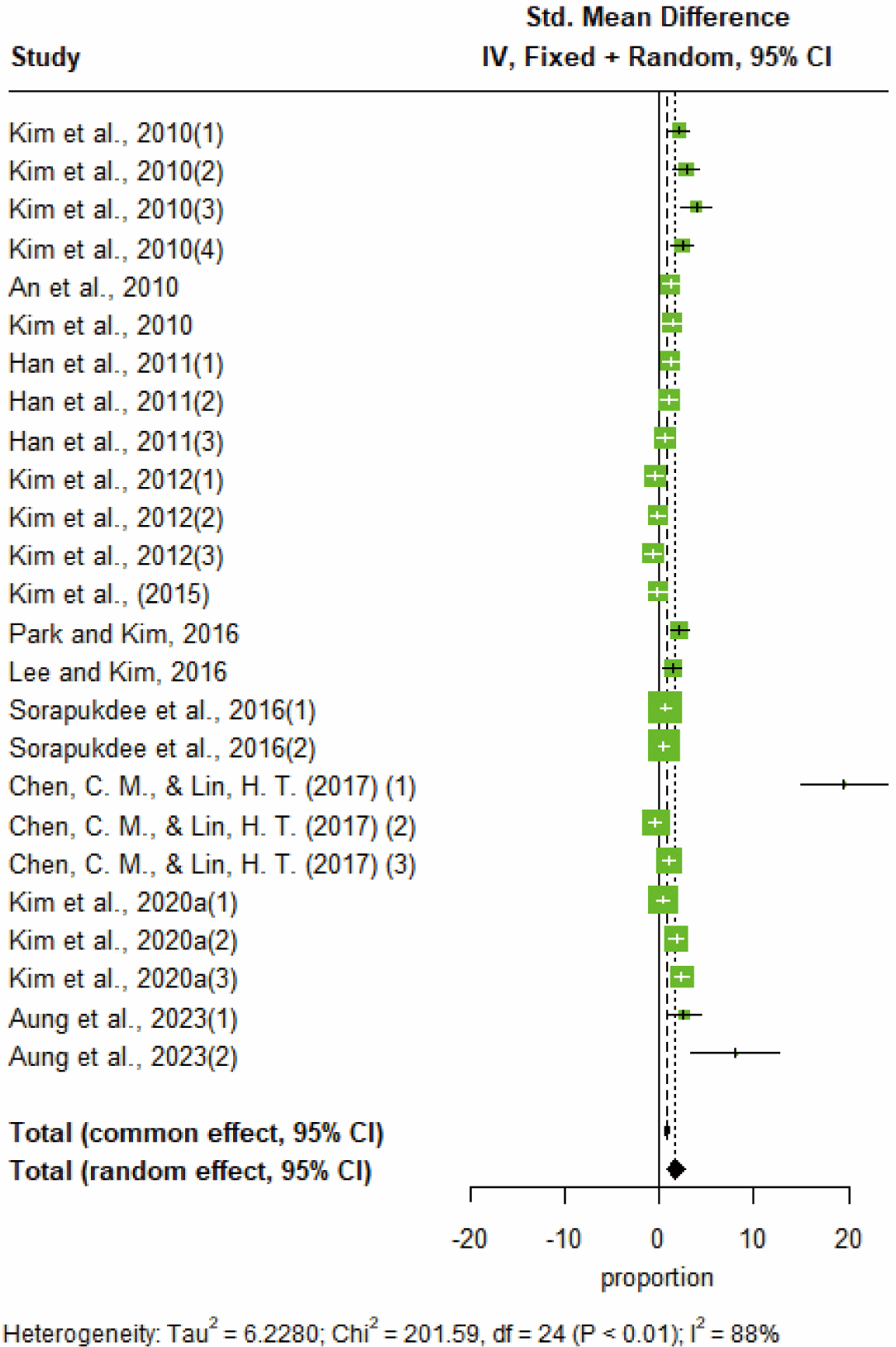
If high heterogeneity of ES is present across studies, it is important to investigate the source because it may impact the pooled effect estimate (Baker et al., 2009). Meta-regression can be used to determine the potential source of high heterogeneity across studies (Swannell et al., 2014). Moisture, protein, fat, ash, TPC, TBARS, CIE L*, CIE a*, CIE b*, MFI, and overall acceptability all showed significantly high heterogeneity (Q; p<0.10; Table 2). However, only the following variables were examined in this analysis: moisture, protein, fat, ash, CIE L*, CIE a*, CIE b*, and overall acceptance. This is because it is not recommended to use meta-regression when there are fewer than 10 studies that have reported the relevant response variable (Littell et al., 2008). The relationship between two variables is measured by the correlation coefficient, which also indicates its intensity and direction (Gogtay and Thatte, 2017). If both the correlation and coefficient values are positive, the relationship is regarded as linear. Alternatively, if there is a non-linear relationship between the variables, such as a curvilinear relationship, the correlation value might be positive even when the coefficient value is negative.
Table 3 shows the meta-regression results of the effect of the humectant level on the quality characteristics of jerky. The humectant levels were significantly correlated with moisture content (r=0.1, p<0.05). This means that a high heterogeneity across studies can affect the result of moisture content. Therefore, subgroup analysis must be considered to identify the specific factors contributing to the heterogeneity. Nonetheless, the relationship was curvilinear because the coefficient value was negative (–0.28). This curvilinear relationship reveals that adding humectants in small amounts can enhance moisture content whereas adding them in large amounts will result in moisture loss in jerky. It is important to regulate moisture levels during the manufacturing process since a high moisture content in jerky can cause spoiling and the development of dangerous germs (Konieczny et al., 2007). Because of this, it is critical to achieve the correct balance between these two elements to generate a high-quality product.
For the relationship between humectant levels and proteins, the estimated r was negative (–0.08) and the coefficient value was –0.08 without showing a significant relationship (p>0.05). This means that a high heterogeneity across studies does not affect the protein content. In addition, there was a positive correlation between humectant levels and fat content in jerk (r=0.02). The coefficient also had a positive value, although it was not significant (p>0.05). In addition, there was no statistically significant association between levels of humectants and ash (p>0.05). There was a curvilinear relationship between the two (r=0.05, coefficient=–1.35). Therefore, the high heterogeneity was not related to the variables (fat and ash content) being investigated.
In the case of color features, CIE L* and CIE b* were negatively correlated to humectant levels (r=–0.12 and –0.1, respectively), although there was no significant relationship between the two variables (p>0.05). In the case of CIE a*, there was a curvilinear correlation (r=–0.13, coefficient=0.09), although such correlation was not statistically significant (p>0.05). This means that high heterogeneity of ES does not significantly impact the variables being investigated. Nonetheless, it is crucial to take into account how humectants affect the color of jerky when selecting a recipe or product. It is necessary to choose an appropriate level of humectants that can contribute to the desired color.
Also, a curvilinear relationship (r=–0.04, coefficient=0.05) between the humectant levels and overall acceptability was noted. However, such a relationship was not statistically significant (p>0.05). This meant that the high heterogeneity of ES did not affect the overall acceptance being evaluated. However, the overall acceptability depends on the texture and flavor of the product (Albright et al., 2003). The jerky may become too moist, soft, or sticky if too much humectant is incorporated, which may lower its overall acceptance. Moreover, too much humectant might make the jerky taste artificial or too sweet. Hence, it is critical to achieve an ideal humectant balance to guarantee that the jerky has the desired flavor, texture, and overall quality.
The moisture content of jerky in meta-regression had a significance at an α level of ≤0.05. Therefore, SMD of moisture content was evaluated using subgroup analysis by dividing the covariates as follows: additives level (<5% and ≥5%) and jerky types (beef, chicken, goat, and pork). As shown in Table 4, moisture was considerably increased when humectant levels were less than 5% (SMD=3.13, p<0.05). However, humectant levels higher than 5% had no effect (SMD=–0.26, p>0.05). This might be because when there is an excessive amount of humectants in a product and the relative humidity is low, the humectants may work overtime to attract moisture. Therefore, humectants can have the opposite effect and pull moisture away from the product, causing it to dry out and decrease the overall moisture content.
| Subgroup | No. of studies | SMD | SE | 95% CI | p-value | |
|---|---|---|---|---|---|---|
| Lower | Upper | |||||
| Moisture | ||||||
| <5% | 18 | 3.13 | 0.79 | 1.579 | 4.674 | <0.001 |
| ≥5% | 11 | –0.26 | 0.92 | –2.070 | 1.540 | 0.774 |
In the findings of meta-analysis, there was no publication bias in moisture, pH, protein, fat, or CIE L* of jerky because the funnel plot showed symmetry and Begg’s test showed a p-value greater than 0.1 (p>0.1). Additionally, the overall acceptability, CIE b*, and ash all demonstrated significant heterogeneity (Q) at an α≤0.10. In contrast, there were fewer than 10 studies that reported TPC, TBARS, and MFI. As a result, tests to evaluate publication bias were omitted for ash, CIE b*, overall acceptability, TPC, TBARS, and MFI since they might produce falsely positive results in these circumstances (Ioannidis and Trikalinos, 2007). For the water activity, shear force, and metmyoglobin, publication bias was found (p<0.1). Each of these three cases had seven, five, and four missing observations respectively, according to the trim-and-fill procedure.
Conclusion
According to the findings of the current meta-analysis, humectant addition had no appreciable impact on water activity, pH, fat, ash, TPC, TBARS, CIE L*, or CIE a* (p>0.05). However, the moisture, CIE b*, and overall acceptability were all considerably increased by humectants (p<0.05). Humectant addition also resulted in significant reductions of metmyoglobin, shear force, and protein (p<0.05). Additionally, humectants had an impact on MFI. Nevertheless, it was impossible to draw conclusions about its effectiveness because there were fewer than ten studies that could lead to false-positive claims. According to subgroup analysis, humectant concentrations higher than 5% did not result in a significant increase in moisture content (p>0.05). However, concentrations less than 5% caused a significant increase in moisture content (p<0.05). In conclusion, the use of humectants can have both positive and negative effects on the quality characteristics of jerky. To manufacture high-quality jerky, it is crucial to regulate the type and quantity of humectants employed, as well as the way they interact with other elements including storage conditions and preservation methods. However, it is crucial to apply them appropriately and pick the right kind of humectant to obtain the intended result. Future studies on humectant use in jerky should concentrate on identifying new and more efficient humectants, maximizing the use of already-existing humectants, and examining how humectants affect the flavor and nutritional profile of jerky. It is also important to research how humectants affect the health as a functional quality of jerky.













